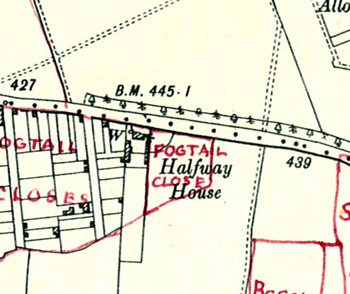The Halfway House Caddington

Halfway House on a map of 1901
The Halfway House: Dunstable Road Caddington (now Luton)
The Halfway House stood in Caddington, though the spot is now within the Borough of Luton. Halfway Avenue commemorates this building which stood at this road's junction with Dunstable Road just east of today's Junction 11 of the M1.
The establishment is listed in one directory – 1851. It was not an old drinking establishment as it is not recorded in the countywide licensing registers which survive from 1822 to 1828. Generally directories named public houses but in the case of beerhouses just gave the name of the licensee with the description: beerseller. At first glance this suggests that the Halfway House was a public house but the fact that it is not listed by name in any later directory suggests rather more strongly that it was a beerhouse.
Bedfordshire and Luton Archives and Records Service has references to it in two collections. In 1870 two men were accused of stealing a sheep and George King, licensee at The Halfway House knew the men - Levi Cooke and Rowland Denton well. He made a statement that on Saturday 3rd September between 5 and 6 a.m. he saw them both pass his house together going in the direction of Luton. He said good morning to them. The property is not listed in the countywide licensing register of 1876 and so must have closed between 1870 and 1876.
It is possible that the Halfway House was another name for The Balloon. It is difficult to be sure due to lack of records but this other drinking establishment also stood on the south side of Dunstable Road and would have been very near to the Halfway House but only the Halfway House is shown on the 1st edition Ordnance Survey map of 1880. George King was listed as occupier of the Balloon in the 1861 and 1871 censuses and may well be the same man as the one who gave evidence in the sheep stealing trial in 1870 when he was stated as being at The Halfway House
The 1871 census states that King was from Great Gaddesden [Hertfordshire]. He was 31 and described as a dealer in hay and straw. His wife was Jane, aged 46, a bonnet sewer from Harpenden [Hertfordshire]. Their daughter was 11 year old Mary Jane born in Caddington. 16 year old Alfred Pratt, an agricultural labourer, was also living with them. He is described as King's son-in-law, a term often used to mean step-son, so he was presumably Jane's son by a previous marriage.
The other material on the Halfway House comes from correspondence in the Macnamara Archive. The house stood on part of an old close called Fogtail Close, formerly part of Chaul End Farm which had come into the possession of the Macnamara family. The incoming tenant - Frederick Hildebrand – took the lease from Thomas Searle in 1890 and also bought his business as a dairyman. He paid rent of £12 per annum [BML6/7/1(v)]. An inventory of the premises lists the following rooms: small bedroom; bedroom over the kitchen; bedroom over the sitting room; sitting room; kitchen or living room; scullery; larder and cellar. There was also a cottage next door. The 1891 census reveals that Hildebrand was 33 and came from London as did his 30 year old wife Florence. They had three children – 5 year old Harry, 7 year old Ethel and 3 month old Gustave.
The Halfway House no longer stands but it was still there in 1927 when the valuer acting under the Rating and Valuation Act 1925, which stated that every piece of land and every property in the country was to be assessed to determine its rateable value, visited the property [DV1/C103/32]. It was then owned and occupied by G. Massey and was constructed of brick, roughcast and slate. It had two reception rooms, a kitchen and a bathroom downstairs with four bedrooms above. The ground floor had a bay window. Outside stood: a weather-boarded and corrugated iron garage measuring 14 feet 6 inches by 13 feet ("in good condition"); a weather-boarded and corrugated iron general store room ("in good condition"); two weather-boarded and corrugated iron barns; an earth closet "in a covered area"; three small weather-boarded fowl houses ("neglect") and a weather-boarded and slated summer house. The valuer commented: "Well kept Lawn with Fountain. The Summer House, Lawn and Fountain are enclosed by a weather-boarded fence. The entire place has a superior appearance". However: "There is no proper water supply, drainage or lighting" though "There is a lawn in front of the house".
References:
- QSR1870/4/5/8-10: statement by the licensee in a criminal trial;
- BML6/7/1: correspondence from the incoming tenant: 1890.
List of Licensees: note that this is not a complete list. Italics indicate licensees whose beginning and/or end dates are not known:
1851: David Ellis;
1870: George King.